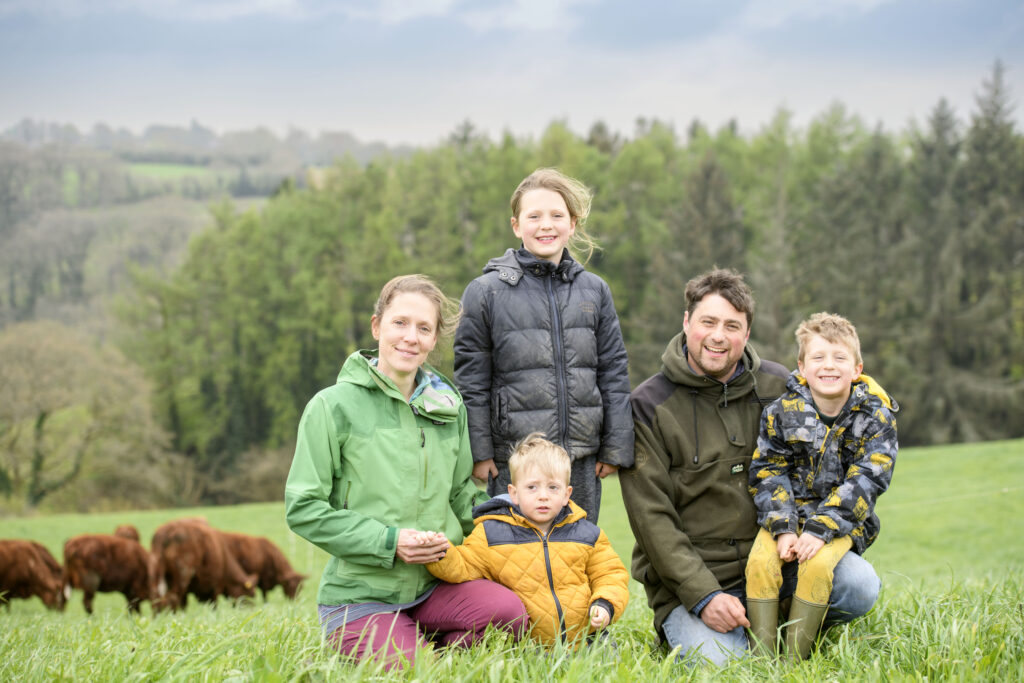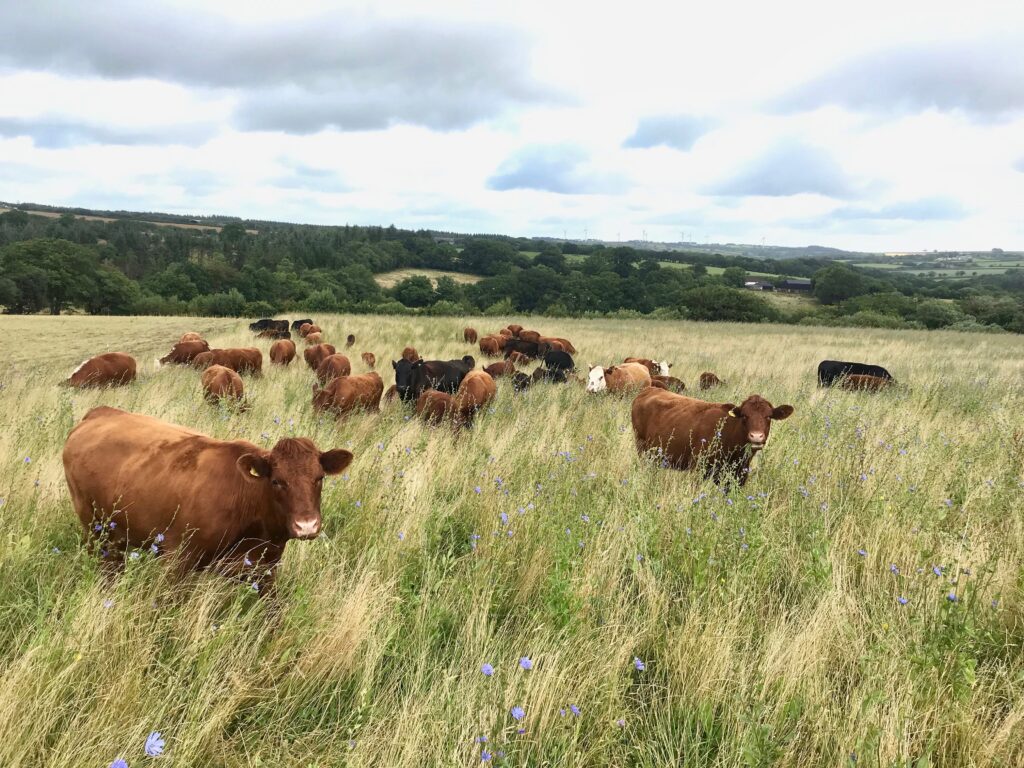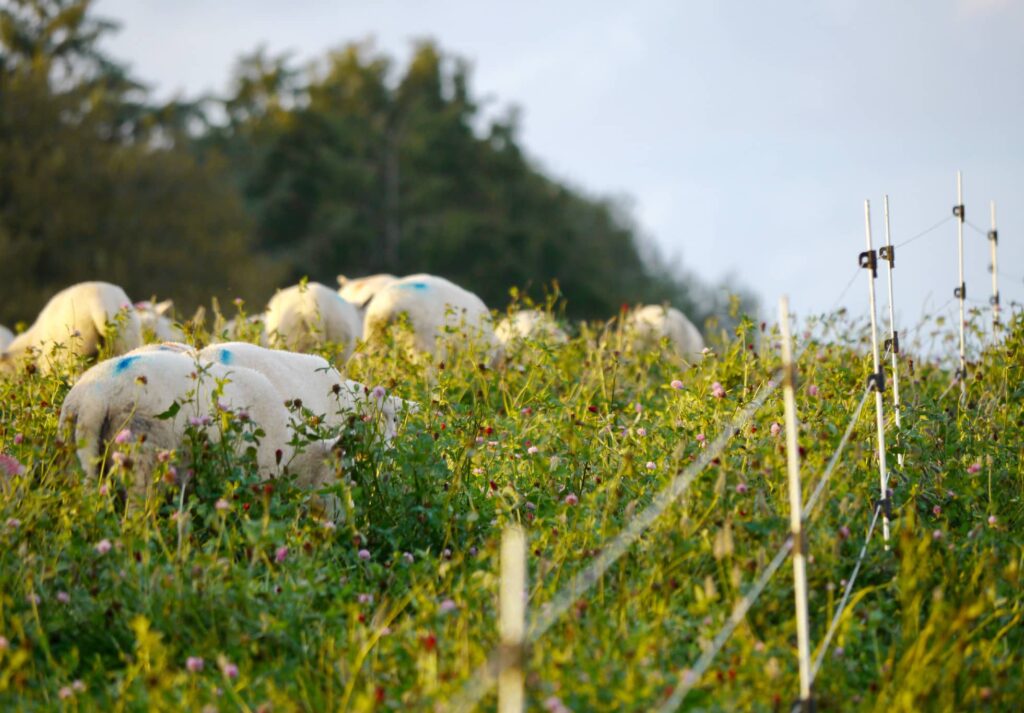Olly Walker, Essebeare Farm 1/3
Tell us about your farm, its location, size, altitude, climate, soils, enterprises, organic/PfL/other status

Rachel & Oliver with children Reuben, Emeline & Arthur (Photo: Adrian Sherratt)
Essebeare Farm sits on ancient culm grassland meadows nestled in a hidden and beautiful Devon valley within the UNESCO North Devon Biosphere. Listed in the Doomsday Book as an ancient farm, it pre-dates enclosure. We farm a traditional suckler herd of 40 native Red Ruby Devonshire cattle and hardy Welsh Lleyn sheep on 90ha Pasture for Life Certified, Organic land, which focuses on rotational grazing, hedge and bank restoration and agroforestry.
We produce finished lamb and beef from diverse herbal leys and restored culm grassland meadows, as well as high quality, forage-raised breeding stock. Roughly half the farm has been managed under a higher-level stewardship (HLS CS) agreement.
Here at Essebeare Farm, we are passionate about managing and restoring the meadows and the hedge banks along the old, ancient lines - we aim to continue this restorative work with a new agri-environment scheme in 2022. We have recreated 2000m of lost earth banks and planted them with a diverse mix of trees and fruit-baring shrubs, specifically with birds and dormice in mind.
In 2015, we set up a rotational grazing platform, ringfencing our paddocks and subdividing with four strand 2.5mm high tensile fencing. We were literally one of Precision Grazing’s first customers. We imported Kiwitec electric fencing direct from New Zealand and began the journey of rotationally grazing a flock of 600 sheep. We have since reduced sheep numbers by one third. We are committed to genetic improvements within the flock and performance record twins.

The farm's Ruby Red Devon cattle (Photo: Olly Walker)
Share with us a general description of the biodiversity on your farm – essentially above ground (but reference to below ground if relevant) – both flora and fauna.
Within the holding, there are areas of semi-natural habitat, which have largely escaped the influence of agricultural intensification. A steeply sloping south-facing bank supports an abundance of wildflowers, knapweed and bird’s-foot trefoil and are interspersed with yarrow and cat’s ear. It is likely that only the steepness of the terrain has saved this area from ‘improvement’. This fragment of lowland meadow contains species that would have been prevalent just 100 years ago in hay meadows and pastures across the country.
Wetter, low-lying fields closer to the Little Dart river, which bounds roughly 70% of our land, support a mosaic of habitat types, ranging from lowland meadow, rush pasture and tall herb fen to scrub and wet woodland rich in meadowsweet. Perhaps the most impressive is the small area of greater tussock sedge swamp, with individual tussocks towering well over 6-foot. There are also several ponds and the stream itself. Each habitat is valuable in its own right, and together, makes a fantastic area for wildlife.
The area is managed through traditional approaches - cutting for hay in late summer; low intensity summer grazing with hardy breeds of cattle and rotational coppicing in winter. Management is vital to maintain this valuable mixture of habitat types and it enables these areas to remain an important part of the productive farm.
The higher, more fertile plateau reaches 200 metres above sea level, and this land hosts a 33ha rotationally grazed herbal ley platform. Bespoke in their design, we carefully selected a high proportion of mineral-mining and compaction-alleviating species to cover all bases in soil health, diversity and stock mineral uptake.
We generously used a mycorrhizal inoculant with all new seed to promote rooting establishment and nutrient exchange. Dryer stony ground is rich in yarrow and lucerne with chicory and plantain staple ingredients. Cocksfoot is favoured over ryegrasses, and Timothy is included with other meadow fescue and hybrid species. Generous scatterings of legumes drive the whole thing on. Then, just add ruminants!

Sheep on herbal leys (Photo: Olly Walker)



